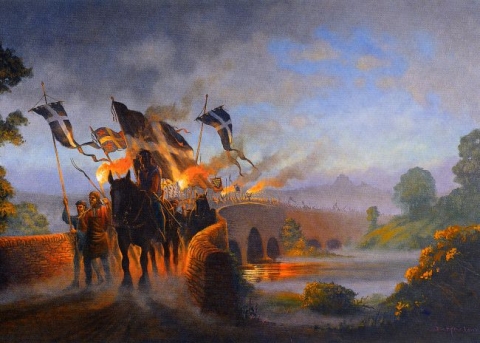Cornish Rising: The Battle of Blackheath 17 June 1497

On this day, the 17 June 1497 at Blackheath in Kent, the Battle of Blackheath was fought between a Cornish army and the army of England’s King Henry VII.
The battle was the main conflict during the first Cornish rising of 1497.
The Cornish army badly frightened King Henry and caused panic in London.
King Henry VII had angered the Cornish people by closing their Stannary Parliament and taxing them to pay for his war with Scotland in which the Cornish wanted no part.
The Cornish decided they would march to London to demand an end to the taxes.
The Cornish gathered an army of nearly 15,000 people, led by Michael Joseph An Gof, who was a blacksmith from St Keverne and Thomas Flamank, a lawyer from Bodmin.
We know the names of some of the other people who joined the Cornish rising of 1497: John Trevysall from Madron, William Antron from Antron, John Tresynny from Penryn, John Rosewarne from Rosewarne, Ralph Retallack from St Columb, Richard Borlase from St Wenn, Thomas Polgrene from Polgrene, John Allan from Stoke Climsland and
William Ham from Stoke Climsland.
Fifty priests and 69 women were also involved in the rising.
The Cornish army marched all the way from Cornwall, across southern England, towards London.
News that a Cornish army was marching towards London caused great fear.
The royal family took shelter in the Tower of London and men were ordered to defend London’s gates and walls.
Noble men from across England rushed to London with their own soldiers to defend the king from the Cornish.
Before long, the king’s army had grown to 25,000 men. At the time, this was one of the largest armies ever gathered by a king of England.
The Cornish army reached Blackheath, four miles from London, on 16th June.
By morning, the Cornish army was reduced to around 10,000 soldiers.
On the morning of Saturday 17th June, the Cornish army lined up opposite the king’s army at a bridge at Deptford Strand.
The bows and arrows used by the Cornish archers were longer and more powerful than those used by the king’s army.
The Cornish placed their archers near the bridge and killed a number of the king’s soldiers as they tried to cross.
Eventually, the king’s army got across the bridge. The Cornish had no reserve soldiers to defend the bridge and the archers moved back to join the rest of their army on Blackheath.
The king’s army was commanded by Baron Daubeney. As he led the charge up Blackheath, he was captured by Cornish soldiers, but was soon rescued by his own troops.
The Cornish army had no artillery or cavalry . Most had no experience of fighting a battle and they only had basic weapons. The king’s army was more than twice the size of the Cornish army. Soon, the king’s soldiers surrounded the Cornish and it was clear that they could not win.
The king’s army won the battle and captured the Cornish leaders.
The Cornish army lay defeated.
Many were taken prisoner, including the leaders Michael Joseph An Gof, Thomas Flamank and Baron Audley.
We do not know for certain how many were killed in the battle – perhaps as many as 2,000 Cornish soldiers and 300 of the king’s soldiers.
Michael and Thomas were executed by the king on 27th June 1497 for leading the Cornish army. They were hanged, drawn and quartered.
The king planned to send the pieces of their bodies to Cornwall as a warning to other people not to rise against him, but was too scared of how Cornish people would react. The king was right to be scared. Later that year, the Cornish rose against him again. And this was but the start of a period in Cornwall's history which saw much resistance and popular risings!
We remember the Cornish leaders and the Cornish who died on that day - 27th June and there is a fine statue of Michael Joseph An Gof and Thomas Flamank in St Keverne, a plaque at the church there, two plaques in Bodmin and one at Blackheath.
Painting: The Cornish army crosses the River Tamar by Donald McLeod, 1996
With thanks to CHT - Kernow bys vyken!






